These two characteristics are shared by both bacteria and viruses.
Nucleic Acids (DNA and RNA) and Proteins
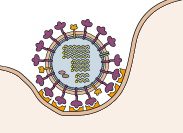
The protein shell of a virus.
Capsid

Viruses outnumber all other life forms on the planet.

True!
Viruses are the most abundant biological entity on earth. They outnumber all other lifeforms on earth combined.
The picture shows a 3-D model of a virus called a bacteriophage. Bacteriophages can infect bacteria such as E. coli.

In what way are the bacteriophage and E. coli alike?
A. They contain antibodies.
B. They reproduce by mitosis.
C. They have identical genomes.
D. They lack membrane-bound organelles.
D. They lack membrane-bound organelles.
Flu (Influenza)
Individuals who have been infected with the flu often describe the contagious respiratory illness as coming on suddenly. The symptoms include fever, cough, sore throat, runny nose, body aches, and fatigue.
Does the flu reproduce through the lytic or lysogenic pathway?

Lytic
Why are cells able to reproduce on their own, but viruses cannot?

Cells are living and viruses are non-living.
This is one way that viruses reproduce that results in quicker onset of symptoms for the infected organism.
The Lytic Cycle
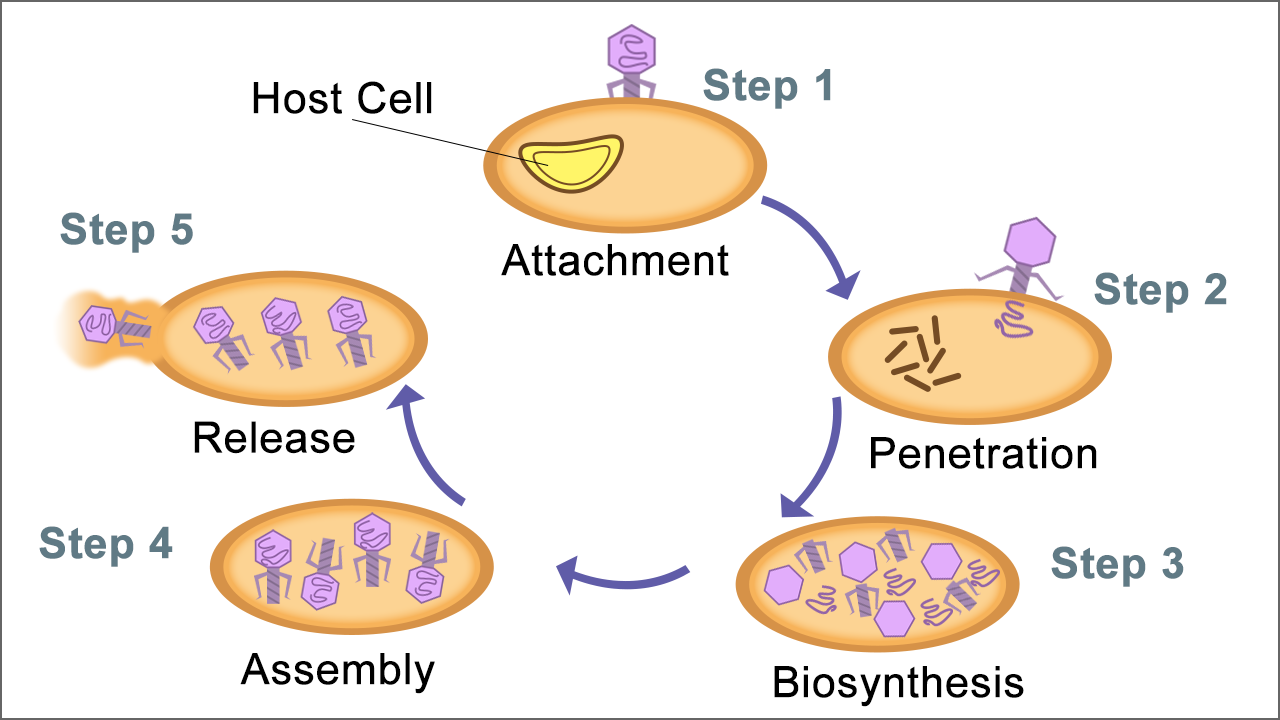
False!
Some viral proteins do good. They may have kept your mother’s immune system from attacking you in utero, for instance.
Which of these describes a difference between between viruses and cells?
A. Cells contain proteins, and viruses contain only carbohydrates.
B. Viruses have flagella, and cells only have cilia.
C. Cells reproduce independently, and viruses require a host to reproduce.
D. Viruses have membranes made of proteins, and cells have membranes made of nucleic acids.
C. Cells reproduce independently, and viruses require a host to reproduce.
Shingles (Herpes Zoster)
Individuals who have been infected with chickenpox may develop shingles as they grow older. The chickenpox virus stays inactive in the body and reactivates later in life as shingles. The symptoms of shingles include a painful rash that blisters and scabs over.
Does shingles reproduce through the lytic or lysogenic pathway?
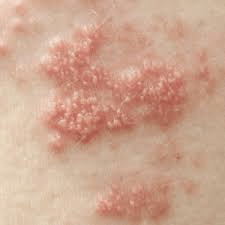
Lysogenic
Scientists are able to determine that a disease has the following characteristics:
1. no self-metabolic process
2. rapid reproduction
3. does not respond to antibiotics
Which of the following answer choices is a possible identification of this disease?
A. food poisoning (E. coli)
B. skin cancer
C. sinus bacterial infection
D. influenza
D. influenza
These are used by the virus to bind to specific receptors on the surface of the host cell. Every virus is specific to the type of cell that it can/will invade.
Surface Proteins
Since viruses are non-living, they cannot evolve.
False!
HIV evolves so quickly that it evolves right out from under our treatments. When a patient begins taking an HIV drug, the drug keeps many of the viruses from reproducing, but some survive because they happen to have a certain level of resistance.
In the 1880s, Louis Pasteur developed a method of weakening viruses. The weakened virus could be injected into healthy individuals.
How is this method effective in fighting viral diseases?
A. The immune system develops antibodies in response to the weakened virus.
B. The weakened viruses attach to unaffected viruses in the host to interrupt the viral reproductive cycle.
C. The rate of genetic mutation in the host is decreased due to the introduction of weakened viruses.
D. Weakened viruses are unable to to enter the host organism.
A. The immune system develops antibodies in response to the weakened virus.
HIV (Human Immunodeficiency Virus)
Individuals who have been infected with the HIV virus can remain asymptomatic (without symptoms) for a period of weeks to years. The symptoms of HIV include fever and flu-like symptoms that subside within 2 to 4 weeks.
Does HIV reproduce through the lytic or lysogenic pathway?
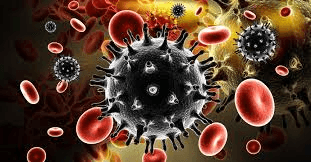
Lysogenic
Mr. Katz researches information on how virus and bacteria compare with one another. Which of the following would be a true generalization?
A. Viruses are able to reproduce similar to bacteria through mitosis.
B. Bacteria and viruses both utilize host cells for their energy.
C. Antibiotics are effective in treating bacterial and viral infections.
D. Bacteria and viruses reproduce using genetic coding found in nucleic acids.
D. Bacteria and viruses reproduce using genetic coding found in nucleic acids.
During this type of viral reproduction, the viral DNA integrates into the host cell DNA. The virus may stay dormant within the cell, and as the cell divides, each new cell contains both viral and host DNA.
The Lysogenic Cycle

Zoonosis is a disease that can be transmitted to humans from animals.
True!
Examples of these diseases are Ebola, bird flu, cat scratch fever, malaria, and ringworm.

Viruses can be transmitted through air, water, food, insect bites, and direct skin contact. Once a virus gains entry to the body, it invades a host in order to...
A. deactivate the host cell's defenses
B. synthesize antibodies for defense
C. metabolize host proteins and grow
D. access cellular processes for replication
D. access cellular processes for replication
Measles (Rubeola)
Individuals who have been infected with the measles often develop symptoms within 14 days of infection. Approximately 5 days after the symptoms begin, the person's fever spikes and a rash appears on their body.
Does measles reproduce through the lytic or lysogenic pathway?
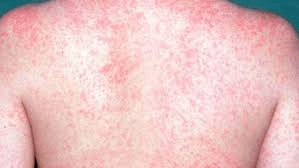
Lytic
Bacteria - Antibiotics
Viruses - Vaccines
What would be a possible description for the letters A, B, and C in the diagram comparing viruses and bacteria?
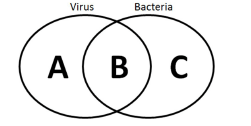
A. A – protein coat; B – nucleic acids; C – living
B. A – organelles; B – nucleus; C – nucleic acids
C. A – cell wall; B – nucleic acids; C – living
D. A – complex structure; B – organelles; C – cell wall
A. A – protein coat; B – nucleic acids; C – living
Viruses that do not contain an extra outer layer called an envelope are considered naked.
True!
All viruses have a protein coating or capsid, but some viruses, such as the flu virus, have an additional membrane called an envelope. Viruses without this extra membrane are called naked viruses.
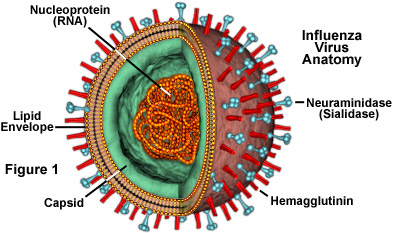
Models of the human immunodeficiency virus (HIV) and an animal cell are shown below.
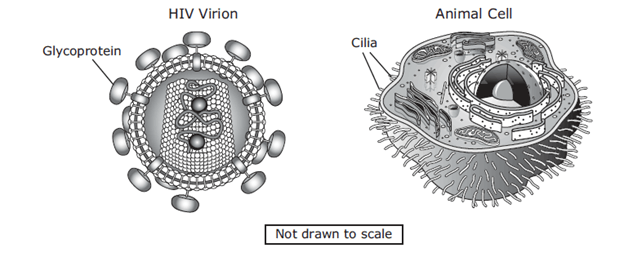
What is the difference in the function of the glycoprotein structures of an HIV virion and the cilia of an animal cell?
A. The glycoprotein structures are used to obtain nutrients, and the cilia are used to secrete proteins.
B. The glycoprotein structures are used to provide physical support for the viral envelope, and the cilia strengthen the cell membrane.
C. The glycoprotein structures are used for attachment, and the cilia are used to move fluids surrounding the cell.
D. The glycoprotein structures are used for defense, and the cilia are used for locomotion.
C. The glycoprotein structures are used for attachment, and the cilia are used to move fluids surrounding the cell.
Severe acute respiratory syndroms (SARS) is an illness caused by the coronavirus. Symptoms including a high fever, headaches, and body aches typically occur within two to seven days after infection of the virus. SARS is more serious in elderly patients. This information suggests that the reproductive cycle of the SARS virus is...
A. lysogenic, because the virus is a coronavirus
B. lytic, because the virus causes respiratory illness
C. lysogenic, because the virus primarily affects older people
D. lytic, because of the quick onset of symptoms after infection
D